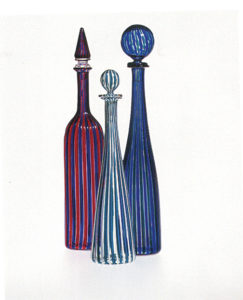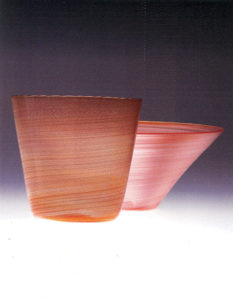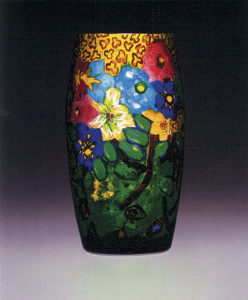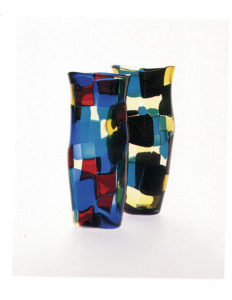 By Robert Reed
By Robert Reed In terms of geography it is only a small island near Venice, Italy. But in terms of artistry Murano glass is one of the marvels of the civilized world.
Clearly Murano glass of old represented the highest achievement in the glass blowing craft. For centuries its fragile and delicate beauty was unequaled and unrivaled. Later its spiraling colors truly astonished its beholders and continued its reign as a world class art glass.
As early as the 1940s antiques historian Harold Bond was referring to Murano glass as “the most wonderful achievement of the glass-blowers art, with a design of perfect poise and balance.”
The island of Murano became one of the earliest glass making centers of the world in part because neighboring Venetian artists felt the threat of spreading fires from glass-making furnaces would be better confined on an island. Then too those in power also thought the island was a good place for confining workers, and thus preserving the secrets of the process.
In the year 1268 glass makers of Venice had formed what would today be defined more or less as a corporation, and moved the entire operation to the nearby island of Murano.
Rigid laws were enacted by the early craftsmen to prevent trained workers from accepting any tempting offers made by foreign countries. Up until that time Venetian crystal glass enjoyed a monopoly over the world, and the secrets of manufacture were closely guarded.
Some accounts suggest glass workers faced the penalty of death if they left the island. Other accounts suggest “they were virtually imprisoned” while trade with other European countries and the Far East prospered.
 Apparently the glass workers were not as troubled with the conditions as one might expect. Writing in the book, Old European And American Glass, author Hudson Moore notes that by 1540 they sought more time at labor not less. Reportedly the workers grew unhappy with the reduced hours caused by observances of church and state, and sought longer work weeks.
Apparently the glass workers were not as troubled with the conditions as one might expect. Writing in the book, Old European And American Glass, author Hudson Moore notes that by 1540 they sought more time at labor not less. Reportedly the workers grew unhappy with the reduced hours caused by observances of church and state, and sought longer work weeks. For a long time production at Murano excelled in the manufacturer of various flat and shallow bowls which were sometimes mounted on stems and decorated with powered gold. They also made distinguished slender and long-necked bottles of remarkable beauty. However their most treasured product was the soda-alkali incorporated cristallo glass which was the envy of all those who saw it. As it was slow in cooling, it allowed craftsman the time to shape it into classic forms.
Bowls, jugs, and bottles grew more and more elaborate and were not only formed into heavier and more massive shapes, but were artfully colored as well.
“By the end of the 15th century Murano glass workers could produce blue, green, purple and opaque white glass,” according to Discovering Antiques author Sylvia Coppen-Gardner. The author attributes the latter white glass as probably being used in the first recorded experiment in the making of European porcelain.
Toward the end of the 17th century however two things were working against the fortunes of Murano glass. For one thing, despite restrictions, enough “guarded” glass workers had slipped away either by escaping or under the guise of commercial visits to allow for competition in other countries. Surprisingly, for example, glass workers had been permitted to make ‘good will’ trips over the years to France and England where their labors and their wares were warmly welcomed. Secondly world markets were developing a fascination for Bohemian style glass and anything in the Bohemian style was forbidden on the island of Murano.
 Thus but the middle of the 18th century the once mighty Murano glass-making empire was on a clear decline. Their light and brilliantly clear glass cups and beakers were still highly prized. However a great majority of their other wares had difficulty finding their once proud status in the world markets.
Thus but the middle of the 18th century the once mighty Murano glass-making empire was on a clear decline. Their light and brilliantly clear glass cups and beakers were still highly prized. However a great majority of their other wares had difficulty finding their once proud status in the world markets. All was not lost on the island of Murano, however, historically speaking.
During the middle of the 19th century glass artist Antonio Salviati lead a revival of sorts by establishing his own glasshouse on Murano. Salviati stressed the old-school of earlier Venetian glass forms, and soon offered an abundance of glassware in the tradition of the earlier classics.
Among other things Salviati in the 1860s opened a showroom in London, England and did a thriving business in old-style glass. The experts disagree as to whether Salviati’s efforts truly duplicated the grand Murano glass of the past or merely imitated it.
The 19th century movement was “sufficiently good enough” to be mistaken for early wares according to Geoffrey Willis in A Concise Encyclopedia of Antiques. However Willis concludes that was not Salviati’s intention. Other sources suggest the enameled bowls, serpent stemmed bowls, and over all latticino were at least very similar to the pieces of centuries earlier because the glass recipes for such glass, while intricate, had changed little in actual practice over the years.
Bond went even further proclaiming that the Murano glass industry was not only fully revived but “even into the early 20th century it was again the foremost artistic crafts in the world.”
What some would refer to as a third resurgence began in the 1920s when glass artist Paulo Venini began crafting drinking glasses and latticinio patterns in the classic tradition of earlier Murano glass. After his own studio prospered Venini added Carlo Scarpa to his staff in the early 1930s. Soon afterwards the two did remarkably well by combining pre-existing techniques with more modern applications of color.
 In the years that immediately followed colors grew even more breathtakingly bright in mosaic and other forms. During the 1940s Venini employed the genius of Fulvio Bianconi to expand the majestic forms already offered. One stunning result was the so-called handkerchief vases which were described “as handkerchiefs softly parachuting down.” The technique involved processing a square of pattern glass which was heated and then draped over a post. As it was allowed to cool in the shape or a bowl or vase the rich colors took on the appearance of a silk handkerchief.
In the years that immediately followed colors grew even more breathtakingly bright in mosaic and other forms. During the 1940s Venini employed the genius of Fulvio Bianconi to expand the majestic forms already offered. One stunning result was the so-called handkerchief vases which were described “as handkerchiefs softly parachuting down.” The technique involved processing a square of pattern glass which was heated and then draped over a post. As it was allowed to cool in the shape or a bowl or vase the rich colors took on the appearance of a silk handkerchief. Together Venini and Bianconi nearly invented new colors for their new handkerchief vases. Typically they crafted in latticino and adding intricate ornamentation with metal expanding the traditional style of original Murano glass. Other vases were created from the using together of blocks colors much like a patchwork quilt. “Other patterns were woven together out of strips of colored glass,” notes John Sandon in the volume, Antique Glass. “Tall bottles known as Morandi, were made from concentric bands of primary colors and these were seen as sculptural art objects and not merely liquor decanters.”
Today there are still over 100 small glassmaking firms and individual glass artisans still active on Murano.















Follow Us